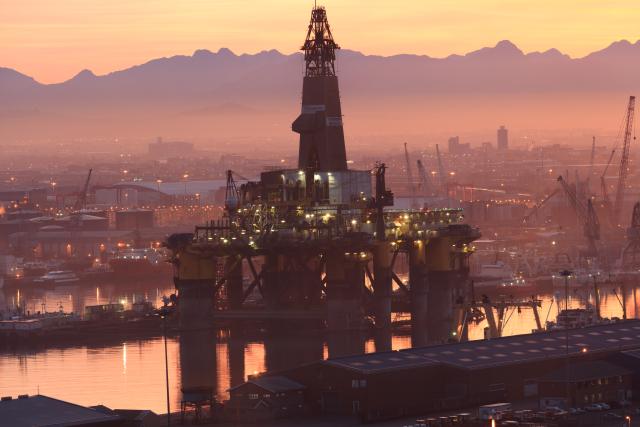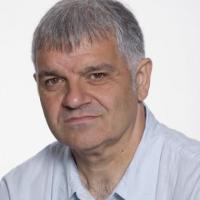
An oil rig in Capetown, South Africa (Source: Shutterstock.com)
CAPETOWN, South Africa—For Africa to realize its potential as one of the most promising exploration regions in the world, supermajors must put their financial might behind the drive. Traditionally, the continent has been the realm of the independents, but that is changing.
Mark Venables, caught up with executives of four supermajors while covering Africa Oil Week to discuss the rise in activity among the big players in the region.
Governments Crucial To Success
Royal Dutch Shell has long established an integrated value chain business in African countries such as Nigeria and Egypt, but it has embarked on new deepwater exploration opportunities in several countries. These included exploration activities in Mauritania, where it is about to complete a significant seismic survey, and recent entry into exploration offshore South Africa. In addition, Shell is progressing a variety of deepwater exploration opportunities in southern West Africa through its strategic alliance forged with Kosmos in 2018.
“These and other potentially promising projects we will mature and derisk in the near future,” Colette Hirstius, vice president exploration for the Middle East and Africa at Shell said. “Next year, for example, we will be preparing a drilling campaign for offshore Namibia, as well as progressing seismic data acquisition on several operations around different countries. Beyond that, we are always looking for opportunities to optimize our portfolio, and Africa will play a large role for Shell in the medium and long term.”
So, what does it take to unlock Africa’s economic potential?
“We face unique challenges and opportunities, often driven by geology and the maturity of the industries,” Hirstius said. “Some of these challenges include the lack of infrastructure, security issues, unstable fiscal and regulatory environments, and limited access to energy. It will take a long-term vision for each country and long-term partnerships between the industry and government built on trust and commitment, and these will be critical elements for success.”
Hirstius said Shell believes strongly in partnerships and that everyone has a role to play. She said the role of government is to create an enabling environment that encourages the industry to invest. “This includes developing and communicating a clear energy strategy; creating a strong, effective, and predictable regulatory and fiscal environment that respects the sanctity of governance and contracts; and provides a secure operating environment,” she said. “And lastly, embedding transparent and clean business practices.
“For industry, it is to deliver its part by conducting activities in a sustainable manner, which means being safe and environmentally and socially responsible,” she continued. “Companies should build local capabilities and capacity, develop local value chains to maximize competitive opportunities for local economies, and, of course, promote innovation and technology. Shell strongly believes that building local capacity and capability is key for helping Africa to achieve its full potential.”
Stable Regimes Required For Investment
Pam Darwin, vice president of Africa at Exxon Mobil Corp., picks up on the theme of stability but adds that there is no silver bullet for success in Africa.
“Our industry must continue to strive to meet energy demand for reducing environmental impact,” Darwin said. “All these efforts take capital, and the competition is greater than ever. Where there are stable and attractive fiscal regimes at present, investments are occurring.
“There is a clear message coming out of the United States where investment in the shale industry or the shale revolution as they call it, has increased dramatically since 2005,” she continued. “Consequently, U.S. liquids production has more than doubled over the past 10 years, generating billions of dollars. In contrast, over the last 10 years, African liquid production has steadily decreased. To tap Africa’s immense reserves, commercial terms need to be in place to draw those investments.”
Darwin is adamant that investment is what is required to drive exploration success. For example, Darwin pointed to Exxon Mobil’s efforts in Guyana, where it experienced more than 40 dry holes before 2014.
“Our team looked at these and came up with some creative ideas for how the basin was formed and looked at a deeper crustaceous play,” she said. “So, with intriguing rocks and attractive fiscals, we were willing to invest. Today, Exxon Mobil has had over 14 discoveries and discovered over 6 billion barrels of oil there with our partners. The discovery will begin producing this year, just four years after the initial discovery. What enabled this was favorable conditions and commercial terms from a supportive government.”
Building On African Heritage
With its heritage and roots in Africa, it is natural that the continent remains vital as part of Total’s portfolio. Last year, 20% of its production came from Africa, which is also home to 16% of its reserves. But looking to the future, that percentage is likely to grow with more than one-third of the French oil major’s exploration budget committed to Africa.
“There are four main technologies that we challenge ourselves to be strong in—deepwater, LNG, petrochemicals and lubricants, and here in Africa, we are very much present with three of those four technologies with deepwater and energy and also retailer and lubricants on the downstream side,” Mike Sangster, managing director of Total E&P Nigeria said. “We are the leading integrated major in Africa, we are present in 43 countries across the continent, all the way across the value chain from the upstream, the midstream, and downstream.”
Sangster points to two of Total’s recent successes in Africa—the Kaombo project in Angola and the Egina Field in Nigeria. In April, Total began production on Kaombo Sul, adding 115,000 barrels of oil per day (bbl/d) and bring the overall production capacity to 230,000 bbl/d, equivalent to 15% of the country’s product. It is the second FPSO unit of the Kaombo project, located on Block 32, 260 km off the Angolan coast in water depths ranging from 1,400 m to 2,000 m.
The full Kaombo development consists of six fields spread over an area of 800 sq. km. Gengibre, Gindungo and Caril were connected to the Kaombo Norte FPSO, which started up last year, while the three fields, Mostarda, Canela and Louro, have now been connected to Kaombo Sul.
“We are getting into producing close to capacity at Kaombo,” Sangster said. “And then in Angola, there is a new wave of developments coming along as well, supported by attractive fiscal terms. And I think in Angola recently we have seen some good initiatives from the government, and you can see that industry is responding by investing in low-cost, short-cycle projects such as subsea tiebacks to existing facilities, and infill drilling.”
The Egina field, located in around 1,600 m of water depths, 150 km off the coast of Nigeria came online earlier this year. When it reaches peak production, it will produce 200,000 bbl/d, which represents about ten percent of Nigeria’s output. The FPSO unit used to develop the giant Egina field is the largest one Total has ever built. “Overall in Nigeria we have about 34 blocks, it is a real mix of everything we have onshore, shallow water and deepwater, we have operated and non-operated, and we have LNG as well as oil,” Sangster said.
BP’s Growing Presence
BP has worked in Africa for many decades, but recently the activity has intensified. “Since 2016, we have delivered seven major projects with eight scheduled to come online by the end of the year,” Jasper Peijs, exploration vice president for Africa at BP, said. “The next tranche of significant projects has already been sanctioned with the final investment decisions expected soon, one of which is Greater Tortue Ahmeyim in Mauritania and Senegal.
“This is the fastest sanction from discovery to FID for an LNG project worldwide. And it is not because it’s easy, the fact it is on the border of two countries adds complexity,” he continued. “The only reason this has been possible is that the two governments worked so well together in a spirit of collaboration. On top of that, it is located in ultradeepwater at a depth of around 2,700 m, it will be accessed by the deepest subsea infrastructure in Africa. At the peak next year, more than 5,000 people will be employed on the project.”
Since 2015, BP has entered six new countries on the continent. In addition to Mauritania and Senegal, there is Cote d’Ivoire, Sao Tome, Madagascar, and the Gambia. “At Cote d’Ivoire, we will start seismic within three months of being on the license, and we should have a good view on prospectively this time next year,” he said. “In Sao Tome, we will start acquiring in December, and in Madagascar, we have worked up three interesting plays and almost 100 leads and prospects ready for next phase decision on 3-D seismic acquisition. On our return to the Gambia, we are working well with the ministry and the NOC and looking to have that development next year.”
So why is BP focusing so strongly in Africa? Peijs cites three reasons—growth, partnerships, and longevity. “Demand for energy in Africa is well ahead of the world average, populations are growing, economies are advancing, and the production of energy is growing even more strongly,” he said.
“Looking ahead, the forecast for energy production in Africa is likely to grow by around 60 percent by 2040, almost twice the global rate. Also, Africa provides opportunities for competitive companies as well as opportunities for long term projects. So, there is great untapped energy potential of Africa in every sense.”
Recommended Reading
Permian Resources Closes $820MM Bolt-on of Oxy’s Delaware Assets
2024-09-17 - The Permian Resources acquisition includes about 29,500 net acres, 9,900 net royalty acres and average production of 15,000 boe/d from Occidental Petroleum’s assets in Reeves County, Texas.
Devon Energy Expands Williston Footprint With $5B Grayson Mill Deal
2024-07-08 - Oklahoma City-based Devon Energy is growing its Williston Basin footprint with a $5 billion cash-and-stock acquisition from Grayson Mill Energy, an EnCap portfolio company.
Private Equity Looks for Minerals Exit
2024-07-26 - Private equity firms have become adroit at finding the best mineral and royalties acreage; the trick is to get public markets to pay more attention.
EOG Resources Wildcatting Pearsall in Western Eagle Ford Stepout
2024-07-17 - EOG Resources spud the well June 25 in Burns Ranch with rights to the Pearsall well about 4,000 ft below the Eagle Ford, according to myriad sources.
Powder in the Hole: Devon May Fire up its PRB in Coming Years
2024-08-23 - Devon Energy is perfecting its spacing and completion recipe in Wyoming’s Powder River Basin play to possibly unleash full-field development later this decade.
Comments
Add new comment
This conversation is moderated according to Hart Energy community rules. Please read the rules before joining the discussion. If you’re experiencing any technical problems, please contact our customer care team.






